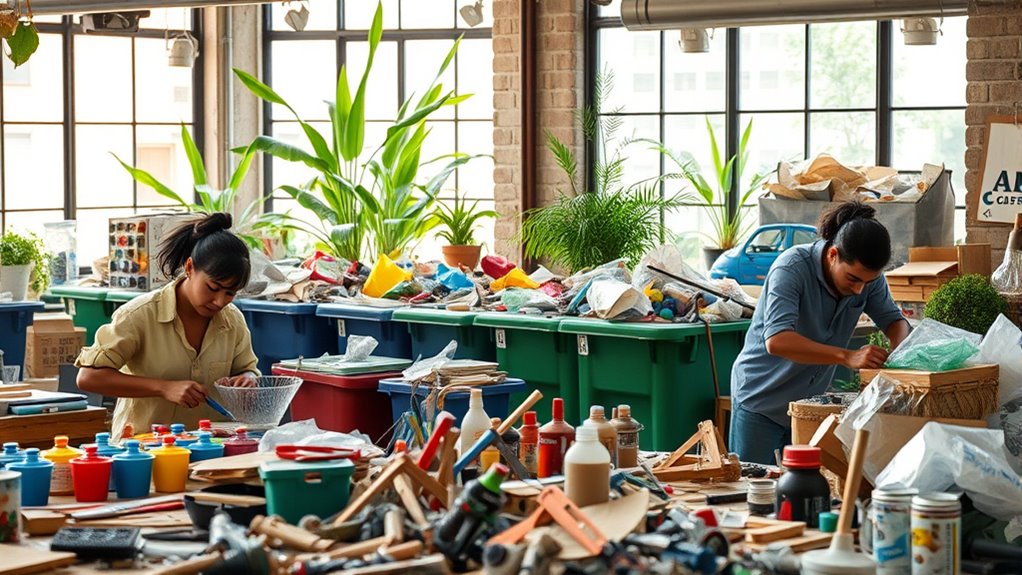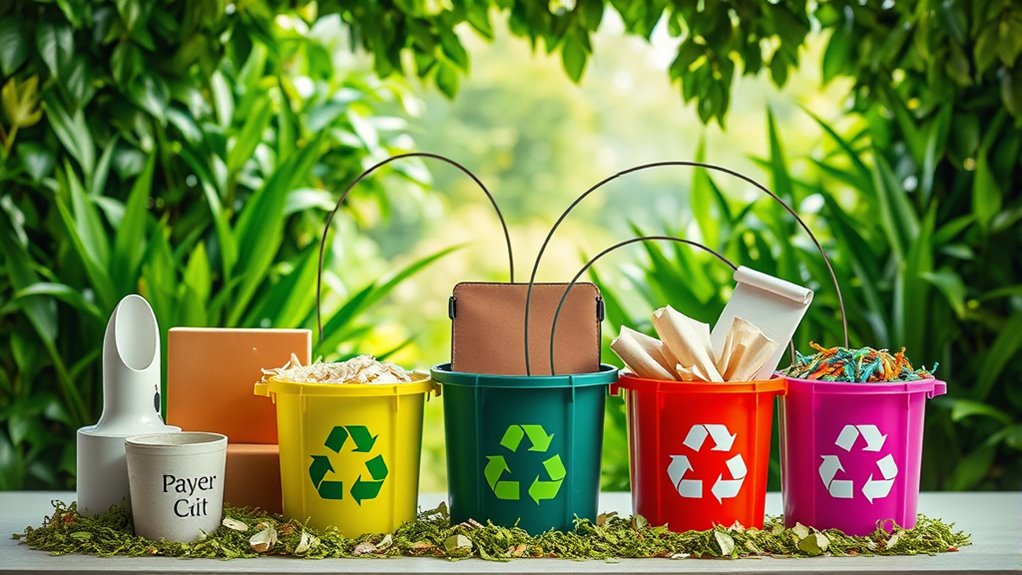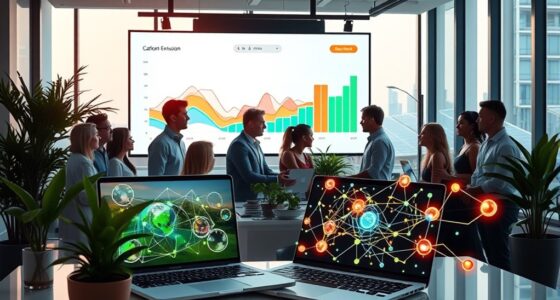The circular economy changes how you design, use, and recycle products. Instead of the old take-make-dispose model, it encourages continual resource use, focusing on longevity and sustainability. You can choose durable items, repair them when needed, and recycle materials at the end of their life. Brands are also shifting towards this model, creating products with easy disassembly and take-back programs. By embracing these principles, you can contribute to a more sustainable future—there’s much more to discover about its impact.
Key Takeaways
- The circular economy model prioritizes resource longevity by designing products for reuse, repair, and recycling throughout their entire lifecycle.
- Sustainable materials are essential in creating durable products that can withstand wear and tear while minimizing environmental impact.
- Consumers play a vital role by choosing products that emphasize repairability and sustainability, fostering a culture of responsible consumption.
- Businesses can adopt circular practices by rethinking supply chains, designing for disassembly, and implementing take-back programs for efficient recycling.
- The circular economy aims to redefine our relationship with products, promoting a shift from wasteful consumption to sustainable practices across various industries.

Have you ever wondered how we can reduce waste while still enjoying modern conveniences? The concept of a circular economy offers a promising solution. Unlike the traditional linear model, which follows a take-make-dispose pattern, a circular economy emphasizes the continual use of resources. This means designing products with their entire lifecycle in mind, ensuring they can be reused, repaired, or recycled rather than thrown away.
The circular economy reimagines our consumption by promoting resource longevity and sustainability over wasteful practices.
When you think about it, the way we consume and dispose of items creates substantial waste. In a circular economy, you’d focus on buying products that are durable, made from sustainable materials, and designed for longevity. You’d check labels for recycling information and consider how often you can repair an item instead of replacing it. This shift in mindset not only helps the environment but can also save you money in the long run.
Imagine buying a smartphone that’s built to last and can be easily upgraded rather than replaced. This scenario isn’t just a dream; it’s a reality in the circular economy. By investing in such products, you’re contributing to a system where resources are kept in use for as long as possible. When a product finally reaches the end of its life, it can be recycled into new products, closing the loop and minimizing waste.
You might wonder how businesses fit into this model. Companies are increasingly adopting circular practices by rethinking their supply chains and focusing on sustainability. They’re designing products that are easy to disassemble, making it easier for you to return them for recycling or refurbishment. Some brands even offer take-back programs, encouraging you to return items you no longer need instead of tossing them in the trash.
As a consumer, you have the power to drive this change. By choosing brands that prioritize sustainability and circular practices, you’re sending a clear message that you value products designed with the environment in mind. You can also engage in community efforts, such as local recycling programs or repair workshops, to promote a culture of reuse. The concept of a circular economy can be extended to various industries, including food and beverage, where packaging and waste management play crucial roles.
In essence, embracing a circular economy isn’t just about reducing waste; it’s about redefining your relationship with the products you use. By making conscious choices, you can enjoy modern conveniences while contributing to a sustainable future. The path to a circular economy starts with you, and every small change can lead to significant impact.
Frequently Asked Questions
How Does Circular Economy Impact Job Creation and Employment Opportunities?
The circular economy boosts job creation and employment opportunities by fostering new industries focused on sustainable practices. You’ll see roles emerge in recycling, repair, and remanufacturing, as businesses shift to resource-efficient models. This shift encourages innovation and skills development, enhancing workforce adaptability. As companies prioritize sustainability, they often seek skilled workers, which means you could find more job openings in green technologies and services, ultimately leading to a more resilient economy.
What Are the Biggest Challenges in Transitioning to a Circular Economy?
Shifting to a circular economy can feel like climbing Everest without oxygen! You’ll face challenges like outdated infrastructure, resistance from traditional businesses, and the need for extensive education on sustainable practices. Additionally, securing investment for innovative technologies and creating robust recycling systems can be intimidating. It’s essential to engage stakeholders and foster collaboration, as overcoming these hurdles will pave the way for a more sustainable future and open incredible opportunities for growth.
How Can Consumers Support the Circular Economy in Daily Life?
You can support the circular economy in your daily life by choosing sustainable products, reducing waste, and recycling properly. Opt for reusable bags, bottles, and containers instead of single-use items. Repair rather than replace whenever possible, and buy second-hand goods to extend their life. Educate yourself and others about sustainable practices, and advocate for brands that prioritize eco-friendly materials and processes. Every small action counts in creating a more sustainable future!
What Role Does Government Policy Play in Circular Economy Initiatives?
Government policy plays a pivotal part in nurturing circular economy initiatives. By gently steering regulations and incentives, they create an environment where sustainable practices can blossom. You’ll see policies that promote recycling, support eco-friendly innovations, and encourage businesses to adopt sustainable models. These efforts not only pave the way for greener practices but also engage you as a consumer, making it easier to embrace a more sustainable lifestyle in your everyday choices.
Are There Successful Case Studies of Companies Adopting Circular Economy Practices?
Yes, there are several successful case studies of companies adopting circular economy practices. For instance, companies like Unilever and Patagonia have implemented sustainable sourcing and product take-back programs. You’re likely to find these initiatives reduce waste and improve brand loyalty. Interface, a flooring company, has embraced recycling and sustainable materials, markedly lowering its environmental footprint. By adopting these practices, you can see tangible benefits, both environmentally and financially, for your business.
Conclusion
In the journey of a product, think of it as a butterfly—emerging from the cocoon of design, soaring through use, and returning to the earth to nourish the soil. Embracing the circular economy means you’re not just a consumer; you’re a steward of this transformation. By choosing sustainable practices, you help create a cycle of renewal, where waste becomes a resource. So, let’s spread our wings and transform our world, ensuring every part of the cycle flourishes.









